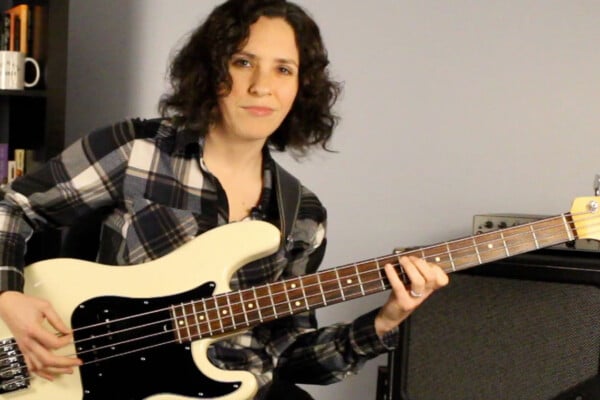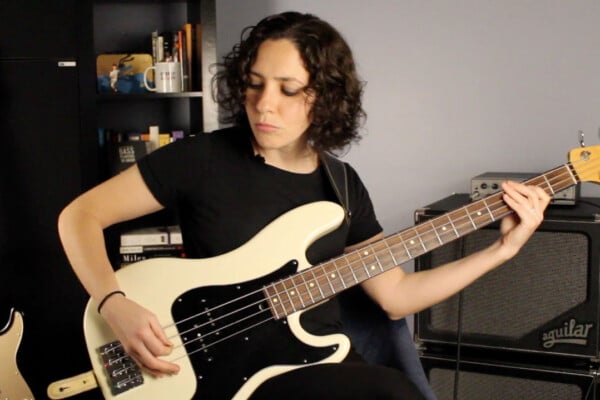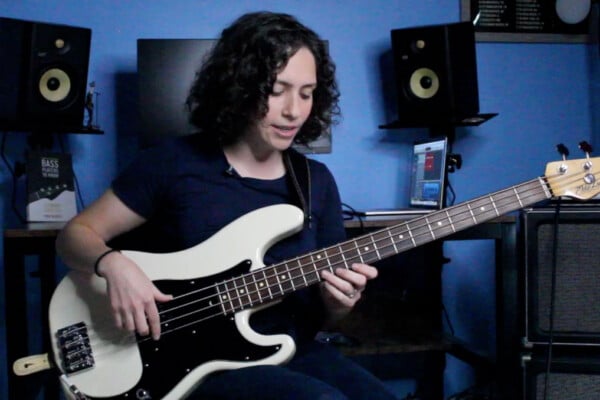Untold Secret to Melodic Bass lesson: Harmonic Dynamics
This is the final chapter of “The Untold Secret.” We’ll be continuing the column by posting excerpts from “Another Look at Melodic Construction” beginning next week.
As chord changes progress in a song, there is tension and release suggested by the harmony. There is a simple key principle to dynamic performance that can be heard in the work of the most accomplished musicians; this principle is that tension and opposition are usually emphasized, dynamically, and there is letup on the releases and resolutions.

In the bass, there are two ways to accomplish this dynamic enhancement; one is through the use of dynamics (volume and intensity), and the other is through the use of register. In the general case, lower notes are stronger and more impactful to the music; and when the two methods are employed together, the effect creates a much more lively and interesting performance, adds a sense of larger shape and presence to the phrasing, and offers inspiration to others in the band, creating a greater sense of flow and majesty to the music. In a word, the performance is more “dynamic.”
The example above shows a crescendo, which for the bass would occur after the note is played, leading to the question “how do I get louder on a note I’ve already plucked?” The answer is—vibrato. Application of vibrato to a sustained pizzicato note can temporarily increase the volume, and definitely adds to the intensity of the note.
There are experienced musicians who do this automatically; others don’t seem to be aware at all of this parameter of performance enhancement, and although their work might be competent otherwise, it will always fall short of its potential. Dynamics are the crowning touch of musical performance, and knowledge of their power and appropriate use is the mark of the true artist.
The functional purpose of the anchor and pivot is to create a sense of motion, of back-and-forth, as we stated earlier. The pivot is an oppositional tone to the anchor; and as such, it’s safe to emphasize it, even in a static harmonic environment. In the general case, the pivot, if played below the anchor in register, will have an emphasized effect. Here’s a “before” and “after” example:

There is no hard-and-fast rule that the pivot should be under the anchor, but those who put it there out of habit are showing an awareness of its dynamic, oppositional value. Sometimes it’s desirable to save this stronger oppositional effect, such as in a static environment to demarcate the end of a phrase:

We’ve had the occasion to notice that violin sections in the better orchestras tend to swell on the dominant preceding a resolution, and decrescendo on the resolution, despite a lack of dynamic marking in the music.
We’ve also noticed a tendency—a natural tendency—for the tempo itself to expand and contract with rises and falls in dynamics. The late pianist Dorothy Donegan was a vivid exemplar of this tendency; as she made her way through a bar, frequently the individual beats would end up different lengths even as the underlying, larger pulse remained relatively steady. In her “boogie woogie” lines, her left hand line would get louder and a little slower as it ascended, then get softer and faster as it descended, creating a very powerful propulsive effect. Some boogie-woogie pianists can tend to sound mechanical; not Dorothy; she would always rock the house with her approach, getting standing ovations after the third or fourth tune. Most musicians are taught that rock-steady time is the most desirable, but the greatest artists allow the tempo to “breathe” with the rise and fall of dynamics and harmonic flow. There is an important distinction that should be drawn between, dynamic performance in a a rhythm section, and un-informed “back phrasing” on the part of a lead voice, wherein the lead voice “pulls” on the tempo, as discussed earlier in the book There is quite a difference between these two effects.

In Conclusion…
With the tools we’ve set forth here, it’s possible to approach the creation of bass lines with a sense of plan. When we know that dynamic and harmonic contrast adds life to a line, we are better able to invest additional energy in the performance, and have a real sense of contributing to the flow and liveliness of a performance. We’re not up there to be safe and anonymous; we’re there to bring all of our energy to bear to create the most exciting, passionate, beautiful performance we can muster. When people ask a bass player to “dig in,” this is the effect they’re looking for. For years, I mistakenly thought it meant to play harder, wear myself out and get blisters. No… we serve the other musicians best by learning about the intrinsic power lurking in musical structure and bringing that knowledge to bear in our performance with confidence, using this knowledge to serve the music while bringing our own energy and flair to the performance.



